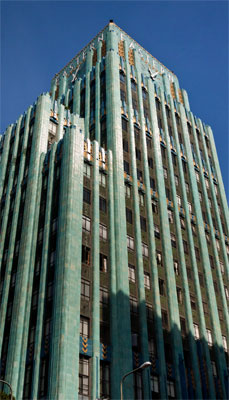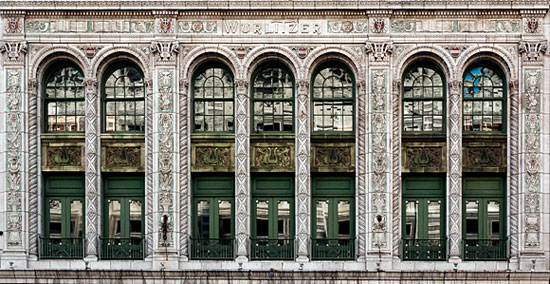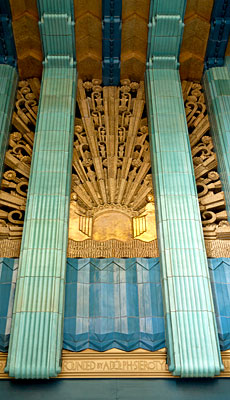We Used to Wait For It
This building was originally part of the financial district, Bill gestures around the room. It was a bank or maybe some sort of trading company, the old Los Angeles stock exchange building is just down the street. Then in the fifties or so it became part of the garment district, then it was pretty much abandoned.
That’s when we first came here, when there was nothing. When downtown Los Angeles was an empty husk of a place, fifteen years ago.
Bill takes a sip of beer. We stare out the window at the wall opposite his loft, enormous levered windows are folded open, a damp breeze that smells of city and ocean, of age, of death and rebirth and more death, moves through the room.
There is something old in the walls here, something lost in the bricks, something in the concrete, the marble. Something you don’t find anymore. Something of the hard-boiled film world popularized by Sam Spade still lingers here. The streets nine floors below still look like lost set pieces from The Maltese Falcon.
 The next day we walk around downtown. Bill is an encyclopedia of architectural history in downtown. I don’t know where he learned it, but it’s obvious he didn’t just read it in a book, he absorbed it the way you do when you love something, when you care enough about something to dig deep into it.
The next day we walk around downtown. Bill is an encyclopedia of architectural history in downtown. I don’t know where he learned it, but it’s obvious he didn’t just read it in a book, he absorbed it the way you do when you love something, when you care enough about something to dig deep into it.
It depresses me, this glimpse of what once was. It makes me afraid of where we are, where we are going. Our path does not feel right. There is something here that we lost, something that we ignored, but should not have. It’s like we just don’t care about our buildings anymore.
The Eastern Columbia building glistens, a monolithic temple of Art Deco, aquamarine spines reaching for the sky. Love it or hate it, it screams someone cared. Even something as simple as the facade of the old Wurlitzer piano building is a work of art, meticulously detailed plaster sculptures covering the columns — lions mouths, lyre crests and harps — creating a miniature world of the imagination tattooed in concrete. The theatre marquees still hold long lost fonts and synchronized flash bulbs ready to draw in the crowds, except that there are no shows, nothing save a sign that reads We Buy Gold. Compramos Oro.
I don’t know anything about architecture, the history of architecture or where architecture is today. But I, like you, can tell when someone cares and when someone is just looking to compramos oro.
 Everything around us seems created for the sole purpose of showcasing what was possible. There is no reason to add the details in the concrete facades, save to show off, to say not just, I made this, but I made this beautiful. Not profitable. Beautiful.
Everything around us seems created for the sole purpose of showcasing what was possible. There is no reason to add the details in the concrete facades, save to show off, to say not just, I made this, but I made this beautiful. Not profitable. Beautiful.
Bill used to work as a project manager for large, modern construction projects in the area. His employers bought gold. Tore it down and sold it for more gold. Bill doesn’t work for them anymore. They went out of business. Compramos Oro. So it goes.
He doesn’t respond to my sweeping generalization about modern buildings right away. We stand in the sidewalk, stare the Wurlitzer building in silence for a while. No. All the projects I’ve worked on started out with the attention to detail that you see in these buildings, but it was all cut out, too expensive, wasteful. A beautiful facade doesn’t make the building worth any more to the companies that build it.
 That’s when I realized that the problem is not simply that we have come to value money above all else, but that we have removed ourselves from the equation. Compramos oro all you want. Pero recuerde que el mundo quiere la belleza.
That’s when I realized that the problem is not simply that we have come to value money above all else, but that we have removed ourselves from the equation. Compramos oro all you want. Pero recuerde que el mundo quiere la belleza.
The problem is not the money that’s being made or not made, but that our buildings are created by companies. We are not men. We are not women. We are not Devo. We are no longer personal, we are no longer connected.
We are companies. Companies are shells created to protect us, to help us. But there is always a cost. Companies have become little more than shells that funnel money from one shell to another, like the street hustler with seashells atop his cardboard box. We build boxes to shuffle money between shells.
Yet it makes no sense to pine for the past. There is no retracing of steps. Build something Art Deco today and it will feel cheap, tawdry, sentimental. There is nothing to be gained in sentimentality. Wallace Stevens was right, sentimentality is a failure of feeling. It’s not sentimental nostalgia you feel on the streets of downtown Los Angeles. It’s loss.
We do not pine for a return to the past, we pine for a reality that has the vitality of what we can see in the past. What has failed us is the reality we have created. It feels devoid of imagination. Reality and imagination, Steven once wrote, are not opposed. They are the same thing. Imagination “has the strength of reality or none at all.” None at all.
That’s what hurts when you look at the modern buildings down here, not that they are not as beautiful as what came before, but that you can feel the loss of beauty, stripped away day by day, year after year until all that remained was the company’s bottom line. The bottom line is not a firm foundation on which to build. We have created a reality where beauty and pride in one’s work have been wrenched away and replaced with mere shells shuffled atop the cardboard remains of our imagination.
Thoughts?
Please leave a reply:
All comments are moderated, so you won’t see it right away. And please remember Kurt Vonnegut's rule: “god damn it, you’ve got to be kind.” You can use Markdown or HTML to format your comments. The allowed tags are
<b>, <i>, <em>, <strong>, <a>. To create a new paragraph hit return twice.